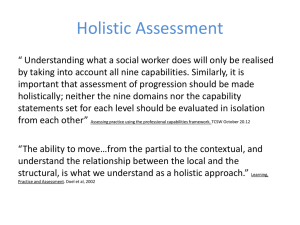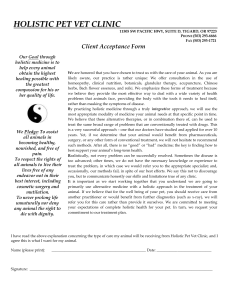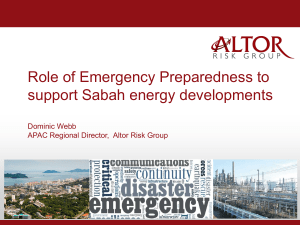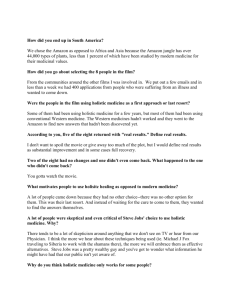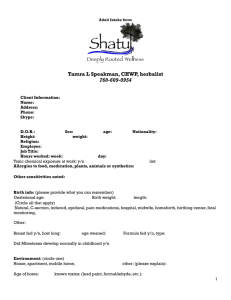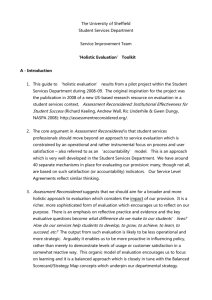Understanding what is meant by Holistic Assessment
advertisement
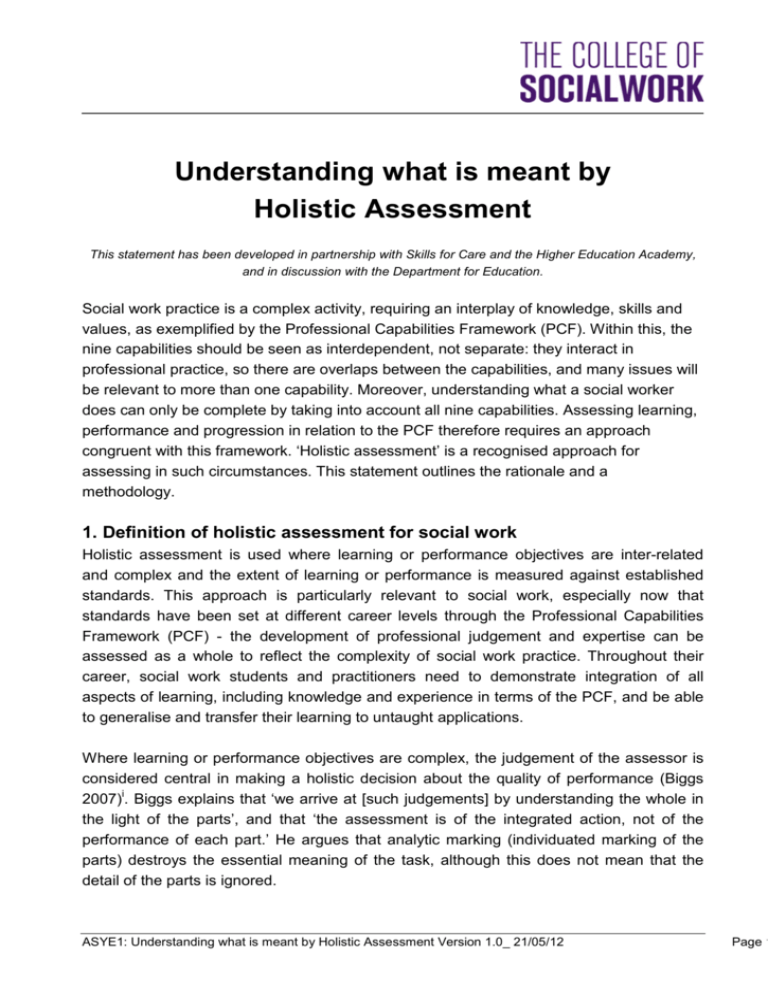
Understanding what is meant by Holistic Assessment This statement has been developed in partnership with Skills for Care and the Higher Education Academy, and in discussion with the Department for Education. Social work practice is a complex activity, requiring an interplay of knowledge, skills and values, as exemplified by the Professional Capabilities Framework (PCF). Within this, the nine capabilities should be seen as interdependent, not separate: they interact in professional practice, so there are overlaps between the capabilities, and many issues will be relevant to more than one capability. Moreover, understanding what a social worker does can only be complete by taking into account all nine capabilities. Assessing learning, performance and progression in relation to the PCF therefore requires an approach congruent with this framework. ‘Holistic assessment’ is a recognised approach for assessing in such circumstances. This statement outlines the rationale and a methodology. 1. Definition of holistic assessment for social work Holistic assessment is used where learning or performance objectives are inter-related and complex and the extent of learning or performance is measured against established standards. This approach is particularly relevant to social work, especially now that standards have been set at different career levels through the Professional Capabilities Framework (PCF) - the development of professional judgement and expertise can be assessed as a whole to reflect the complexity of social work practice. Throughout their career, social work students and practitioners need to demonstrate integration of all aspects of learning, including knowledge and experience in terms of the PCF, and be able to generalise and transfer their learning to untaught applications. Where learning or performance objectives are complex, the judgement of the assessor is considered central in making a holistic decision about the quality of performance (Biggs 2007)i. Biggs explains that ‘we arrive at [such judgements] by understanding the whole in the light of the parts’, and that ‘the assessment is of the integrated action, not of the performance of each part.’ He argues that analytic marking (individuated marking of the parts) destroys the essential meaning of the task, although this does not mean that the detail of the parts is ignored. ASYE1: Understanding what is meant by Holistic Assessment Version 1.0_ 21/05/12 Page 1 To further understand holistic assessment, it may be useful to consider the analogy of the preparation, serving and assessment of a meal. A holistic assessment is made when the meal is judged on its overall taste, quality and presentation etc, however if one part of the preparation or an ingredient is missing or below standard, then this will impair the quality of the final product. In making an analysis of what was deficient, the process and individual components will need to be examined. Furthermore, the quality standard for judgement will differ, according to whether this is a corner café or a Michelin starred restaurant. There are also clear analogies with the assessments that social workers have to make about service users and carers in practice, and in relation to which Munro and others have emphasised the need to gain holistic understanding, using professional judgement, rather than relying on prescribed tools. 2. Principles and conditions for holistic assessment These principles apply to assessment across the whole of the professional capabilities framework. 1. Assessment is progressive over a period of time (e.g. initial qualifying placement, ASYE), leading to effective summative assessment. 2. Assessment must be consistent with the appropriate PCF level descriptor, and include sufficiency and depth of evidence across all nine domains. 3. Individual capability statements will be important in terms of providing detail of expectations for each domain, and particularly significant to identify gaps, areas of development or concerns. 4. The assessment process and judgement must be trustworthy, reliable and transparent (e.g. include clear guidance in handbooks, assessment panels, triangulated evidence1, audit trails2 ) 5. Evidence must include the ability to reflect critically, including reference to different sources of knowledge and research. 6. The learner will contribute evidence for assessment but the professional judgement of sufficiency must be made by a registered social worker (at initial qualifying level, assessors must meet the Practice Educator Professional Standards). 1 evidence is collected from more than one source and over time 2 The term ‘audit trail’ is used to indicate a precise sequence of activities over the assessment period which facilitate the process of making transparent and reliable judgements based on evidence. ASYE1: Understanding what is meant by Holistic Assessment Version 1.0_ 21/05/12 Page 2 3. Practical Application – guidance across the PCF The assessment of the Assessed and Supported Year in Employment (ASYE) and practice learning placements will be progressive and summative. It is important to remember that the design of assessment strongly affects how and what people learn3 (often called the ‘backwash effect’); this may be positive (reinforcing intended learning outcomes) or negative (when people learn to pass rather than learn to learn). A positive ‘backwash’ is needed for ASYE and initial qualifying practice learning to ensure effective holistic assessment and a positive outcome for learners, practitioners, assessors, and people who use social work services. All PCF holistic assessment guidance (templates, case studies, assessor report etc) should recommend that the first part of any assessment reports provides an overall judgement, taking into account capability across all nine domains of the PCF, referencing the level descriptor, and building on any interim review. This may be followed by an assessment comment on each of the nine domains identifying strengths and areas for development/concern (including reference to individual capability statements where there are areas of concern). It is suggested that where applicable reference be made to the learning agreement to provide the learning context (outlining, for example, any adverse impact on the period of learning, such as staff shortages or the absence of the supervisor.4 To support assessors, at initial qualifying and ASYE, it is suggested that exemplars be provided for guidance, including ones specifying success, marginal achievement and failure. The HCPC statements of proficiency will also be referenced. 4. Quality Assurance TCSW are considering whether the criteria for trustworthy judgements outlined by Knight (2006)ii should be included as part of the quality assurance indicators. These are: 3 • • Observations of several slices of practice In different settings and at different times • • By different observers Made by those capable of marking and judgements5 • With reference to known and agreed criteria or standards See for example Biggs op cit 4 Skills for Care and TCSW are taking forward development work on supporting materials and templates for an assessor report that can be used by employers in initial qualifying and ASYE assessment processes. 5 This indicator has been adapted from Knight’s original text – changes and additions are in italics ASYE1: Understanding what is meant by Holistic Assessment Version 1.0_ 21/05/12 Page 3 5. Conclusion This paper sets out the principles for holistic assessment. Further guidance will be developed, but this can be used to start discussions and thinking around local processes. i Biggs, J. (2007) Teaching for Quality Learning at University, Buckingham, SHRE and OU ii Knight, P. (2006) ‘The local practices of assessment’ in Assessment & Evaluation in Higher Education, 31 (4) pp. 435–452 ASYE1: Understanding what is meant by Holistic Assessment Version 1.0_ 21/05/12 Page 4
